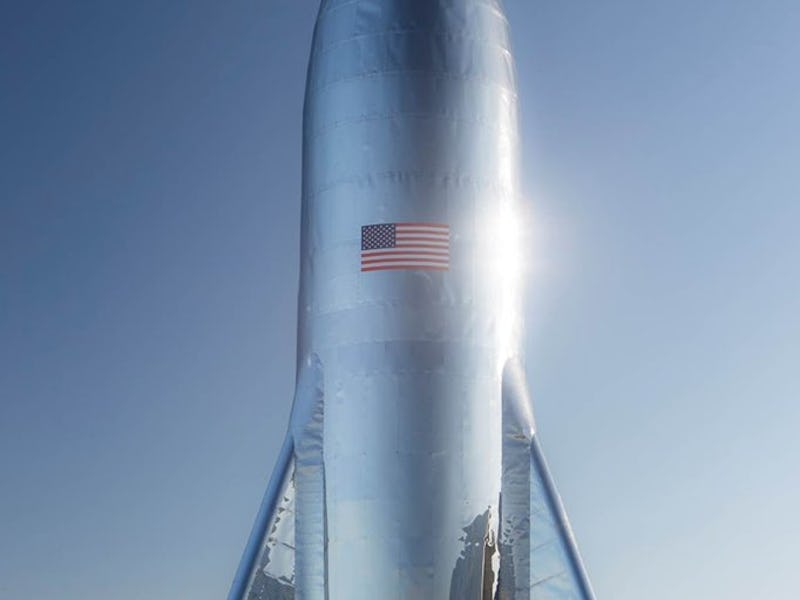SpaceX Starhopper: Tiny Ignitors Sparked Setback for Elon Musk’s Mars Plan
Musk, who wants to ditch the spark plug in cars, is bringing them more into rockets.

Three…two…one…ignition?
Viewers of SpaceX’s livestream Monday expected to see the company’s Starhopper rocket launch up to 150 meters in the air at the Boca Chica Beach facility in Texas. Although one small hop for a rocket, the launch could have formed part of one giant leap for rocket-kind: the Starhopper is the forerunner to the Starship, a vehicle intended to send humans on a manned mission to Mars.
Just 0.8 seconds after the scheduled launch around 6 p.m. Central time, SpaceX pumped the metaphorical brakes on the Starhopper. The water tower-like, stainless steel construction would have to fly another day.
“Igniters need to be inspected,” SpaceX CEO Elon Musk explained to his 28 million Twitter followers in the aftermath. “We will try again tomorrow same time.”
With the Starship, Musk is tantalizingly close to achieving one of his dreams for the future of space exploration. Its Raptor engines use liquid oxygen and liquid methane, which unlike rocket propellant could theoretically be harvested from the atmosphere on Mars and other planets. Combined with a reusable rocket design, and the Starship is close to enabling a planet-hopping network of refuel points where astronauts explore the solar system further than ever before.
“BFR [the former name of Starship] is really intended as an interplanetary transport system that’s capable of getting from Earth to anywhere in the solar system as you establish propellant depots along the way.” Musk said in September 2018. “Mars, Moon, maybe Venus, the moons of Jupiter, throughout the Solar System.”
On Tuesday, that space-age vision was momentarily hampered by what seemed to be a rather low-tech problem: bad wiring.
SpaceX's paused Starhopper test.
SpaceX Starhopper: How to Light a Mars-Bound Engine
For Starship, SpaceX is developing a completely different engine. Instead of just using a different fuel for power, the Raptor engine also uses a completely different lighting mechanism. It’s a big departure from the Merlin engine, the rocket propellant-fueled design used by the Falcon 9 and Falcon Heavy.
The Merlin engine, Teslarati notes, mixes a pair of materials called triethylaluminum-triethylborane. They create green light and explode when they touch, offering a simple means of igniting the engine. Relying on a material like this, however, means planet-hopping missions would require astronauts to replace them somehow. Away from Earth, that could prove difficult.
The Raptor uses what Musk referred to in February as methox torch igniters that act as “heavy duty spark plugs.” Similar to how an internal combustion engine uses electricity to ignite the fuel, these plugs “ignite dual blow torches that ignite preburners & main chamber.”
It’s perhaps a little ironic that, having spent so much energy seeking to rid the automotive world of spark plugs with the Tesla electric car, Musk finds himself coming back to them in the world of rockets. It’s nothing new: NASA used a similar design for the RS-25 engine on the space shuttle.
“Raptor uses dual redundant torch igniters,” Musk explained via Twitter. “Better long-term, but more finicky in development.”
A Raptor engine test fire.
So what was the problem with Monday’s launch? Musk explained that it “appears to be a wiring/connector issue.” Even the CEO of Tesla can’t escape bad spark plug wiring. Musk described the ordeal as “rather embarrassing.”
SpaceX won’t have to wait long to find out whether the wires are ready, with a launch expected to take place later on Tuesday. Assuming a successful launch, Musk is expected to host a press conference in mid-September to describe the next steps. This will take place after the first version of the full-size Starship receives three Raptor engines, moving body fins and a landing gear. The final Starship is expected to combine with a Super Heavy booster to offer more than 40 Raptor engines.
Perhaps little wonder that Musk declared in June 2019 that SpaceX would aim to produce a new engine every 12 hours by the end of this year.